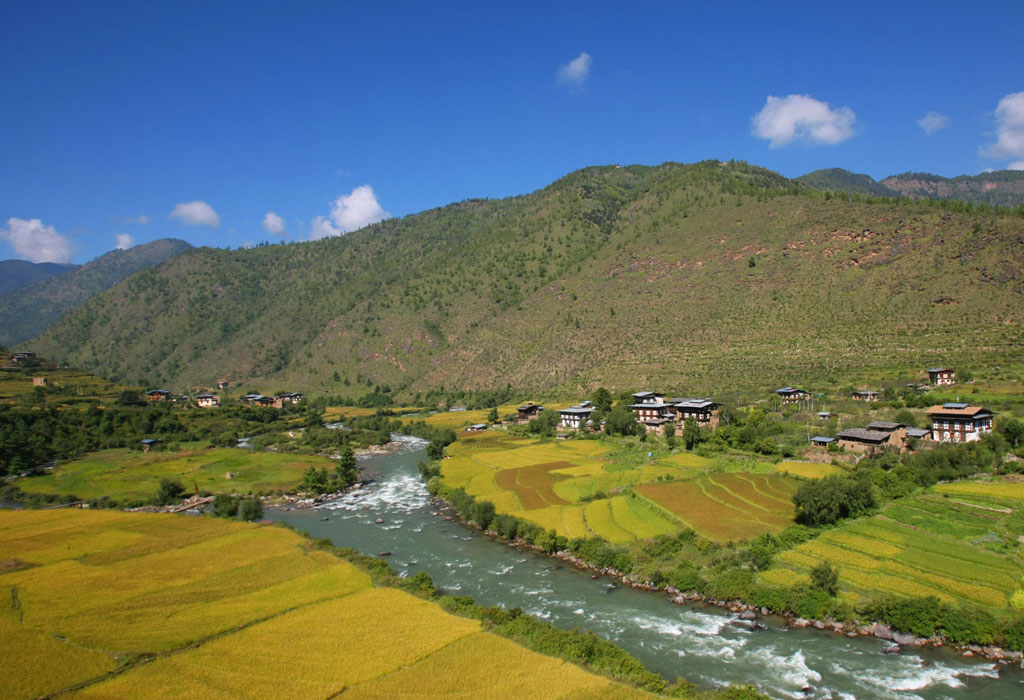
As Bhutan is known for her peace and environment friendly way of life, we provide Eco-tours and village life experiences. This is our special package and is one of the most rated and recommended package for holidays with learning experience.
Nabji – Korphu Trail Eco Tour ( 5 Nights | 6 Days )
Opened in 2006, this trail is an ideal post-harvest/winter trekking open from October up to the end of March. Set out in the Jigme Singye Wangchuck National Park, a park with an ecological rich environment, in central Bhutan.
The trail is a six-day low-altitude trek (between 693m/23100ft and 1,636m/5453ft) through six different villages located inside the park. Starting point Riotala (1060m/3533ft) and final destination Tongtongphey (1061m/3537ft) are two small villages along the Trongsa-Zhemgang road, situated in the buffer area of the park at the east side of the Mangde Chhu (river).
You will possibly see the Golden Langur ( Trachypithecus geei ), one of the rarest primates, which can only be found in Bhutan and neighbouring Assam, Rufous-necked Hornbill ( Aceros nepalensis ). It is a superb place for birding (common mynas, blue-fronted redstarts, long-tailed shrikes and Eurasian sparrows, to name just a few common species, but spotted are also serpent eagle, golden-throated barbet, and the yellow-bellied flower pecker) with a wide variety of flora.
The area is also culturally significant, symbolized among others by the presence of a commemorative pillar in the temple of Nabji. The pillar is a symbol of peace negotiated between the two kings (King Nauche from India and King Sindu from Bhutan ) intermediated by Guru Rimpoche in the eight century. Along the six day trail more traces of Guru Rimpoche’s presence during those days can be found.
The last two days of the trek will go through the homeland of the Monpa people. The small traditional villages of the Monpa community are scattered on the slope overlooking Mangde Chhu. The Monpas are considered to be the first settlers in Bhutan.
Trail Itinerary
Day 1 : Riotala – Nimshong
Total walking distance:6.5km; 3-4 hours
Begin the day with a brief tour through Trongsa Dzong and its Ta Dzong. You will then be driven to Zhemgang with a halt in Riotola. The Nabji Trail begins; keep an eye open for deer and macaques along the way but notice the beautiful view over Mangde Valley as well.
The trek starts with a steep descent of 693m/2310 ft, to the bed of Mangde River. After an hour from the river, you can rest at a place called Matling (804 m/2600 ft). You then come across a chorten, the entry to Nimshong village which is a steep climb for about two hours from the river.
Nimshong village (circa 58-household) has a population of about 465 people. The campsite (1319m/4397 ft) is just beside the Nimshong Community School next above the village.
Day 2: Nimshong – Nabji
Total distance: about 13km; 4-6 hours Nimshong Campsite (1319m/4397 ft)-Nabji Campsite (1,300m/3827ft)
Early morning, a guide will take you to the local temple. From there the hike will go through a lush broadleaf forest alive with abundant bird and mammal life, with possible sightings of Golden Langur and Rufous-necked Hornbill. The temple of Nabji –which means ‘promising’ or ‘oath’- harbours the stone pillar that marks the peace between the Kings of Bumthang and Assam, brokered by Guru Padmasambhava in the 8th century. In the village you can find rock remains of a blacksmith (one of the reincarnations of Pema Lingpa).
Overnight at campsite surrounded by the rice fields of Nabji.
Day 3 : Nabji (1,300m/3827ft)-Korphu (1,636m/5453ft)- Nabji: Total distance: 9.5-13km; 4-5 hours
From Nabji, we begin a day’s hike to Korphu village, situated on a mountaintop at an altitude of 1,500m/5000ft. The village consists of 76 households, with an approximate population of 600 people. It is a spectacular hike uphill, and the view from the clustered village of Korphu is breathtaking. It is possible to visit Korphu’s temple, which houses the sacred relics of Pema Lingpa. A local lunch will be provided in the village. In the mid-afternoon, we hike back to Nabji.
Day 4: Nabji/Korphu – Kubdra Camp site (1636m/5,453ft)
Total distance: 11-14 km; about 5-7 hours
The trek today starts on a trail to Kubdra village, leaving Nabji village at the holy tree. You will come across dense forest, big trees with clippers, orchid and small bamboos.
After 5 to 6 hours hike, you can rest on the benches provided; enjoy your lunch with a nice view of water fall at a place called Zhelyung (1565m/5217ft.).
A few hours later you will come across the ethnic group (Monpas) inhabited in Kubdra. Kubdra is situated in the middle of the forest, around 6 hours walking from Nabji. The habitat you traverse is very attractive for tigers and leopards (though it is very rare to spot them, droppings and spores can be found).
Day 5: Kubdra (1636m/5453ft)-Jangbi (1368m/4560ft)
Total distance: 13-14,5km; approximately 6 hours
The hike continues from Kubdra to Jangbi village. Again traces of Guru Rimpoche can be found along the way (foot print, dragger and hat).
We will briefly visit the small village of Phrumzur with its temple (at 1,400m). From the site of the temple there’s a good view over the valley, here lunch will be served. From Phrumzur the hike continues, with great vistas and pristine forest along the way. Camp will be set near Jangbi village with a beautiful view over the valley and Mangde Chhu.
Day 6: Jangbi (1,368m/4,560ft)-Tongtongfey (1,061m/3,537ft)
Total distance: 7-9.5km; about 3-4 hours)
Today, there is a steep descent of 950 meters, which will bring you to the bridge crossing the Mangde Chhu; after that there will be a last climb to Tongtongfey.
From here, the bus will bring you back to Trongsa. If time permits, you can visit the Kuenga Rabten Palace and the Nunnery (on the way back to Trongsa).
Overnight in Trongsa.